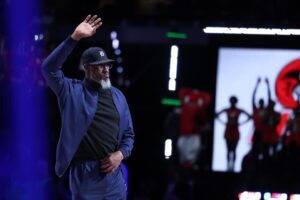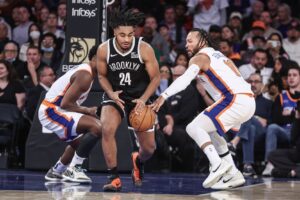The LA Clippers executives must have had high expectations when they acquired coach of the 2008 NBA Champion Boston Celtics, Doc Rivers, in 2013, giving up a future first round draft pick to ply the former Coach of the Year (’00 season) away from Beantown. A basic understanding of regular season statistics will tell you that Rivers has mostly lived up to these expectations, winning almost 68% (195-94) of contests since becoming Head Coach.
However, closer examinations of his reluctance to roster overhaul and of his playoff record tell a different story.
Analyzing the Doc Rivers Era in Los Angeles
Wings of Wax
The Clippers restricted their title hopes on June 16th 2014 when they restructured their front office, promoting Rivers to President of Basketball Operations while staying on as head coach. Without any previous formal front office experience, Rivers was given final say on all things Clippers basketball, from rotations to free agency. This is not (yet) to say that the team’s inability to reach even the Western Conference Finals falls entirely on him. However, it is important to note that the onus of roster improvement fell into the hands of someone working outside his own expertise.
In fact, there is not much data to support the promotion from the outset or even now. Consider his tenure with the Celtics. Before Danny Ainge executed two of the biggest trades of the century in landing Ray Allen, Kevin Garnett, and a draft pick that would become Glen Davis, Rivers sported a playoff record of 8-14. He did not oversee any of the pivotal free agent final decisions during that 2007 offseason, either, when Ainge signed James Posey, Dahntay Jones, and Eddie House, among others. While there have been reports that he was involved with personnel decisions in Boston, Rivers has certainly never achieved the same level of front office success as Ainge or his Clippers’ predecessor, Neil Olshey, who David Stern gifted traded for Chris Paul in the 2011 season.
The transactions Rivers has made in his tenure look more fit for Ice Cube’s new 3 on 3 tournament than for a contending playoff team. From 2013 through the blustery depart of the bigoted Clippers owner Donald Sterling, Rivers landed Darren Collison, Chauncey Billups (only two years before ESPN snagged him), Antawn Jamison’s corpse, Rasheed Wallace’s size 46 shorts, Stephen Jackson, Hedo Turkoglu, Glen Davis (again), The-Artist-Formerly-Known-As Danny Granger, Lance Stephenson, Branden Dawson, Wesley Johnson, Paul Pierce’s wheelchair, and like the cherry on top of a slowly melting sundae, his own son, Austin Rivers.
Barely any of these guys lasted more than a season, but Rivers* was able to trade for Jared Dudley and J.J. Redick in the same offseason, marking the most successful move to present day. If you want to give him credit for resigning DeAndre Jordan, fine, but the infamous chair in front of the door and Blake Griffin probably had more to do with that. None of these moves are the same franchise altering decisions that lead to a NBA title. These are the acquisitions a team more familiar with Conference Finals makes.
Relying on Chris Paul, Blake Griffin, and Deandre Jordan, the Clips have always believed themselves to be closer to the Golden State Warriors and Cleveland Cavaliers of the league than the Toronto Raptors and Memphis Grizzlies. And that may very well be Doc Rivers’s biggest flaw.
A New Big Three
From the hollowed courts of Rucker Park to the oft-vile online lobbies of Halo video games, “Run It Back” has been the age-old adage to signify that the losing team feels confident enough to correct their errors, to maximize their production, if only given another opportunity. Unfortunately, four years into The Doc Rivers Experience, LA fans may be feeling like this saying has run its course with the current stars.
Chris Paul brought legitimacy back to a historically bad franchise. With an uncharted career arc, Blake Griffin brought an instance of unfathomability and optimism. Deandre Jordan has brought all the flair you could imagine from a slam-dunk only big man. The trio deserves praise for the success they have achieved in their three years together under Rivers’s tutelage. Thirty-three playoff games over three seasons is a high benchmark for success matched only by the elites. However, fifteen wins to eighteen losses is an underwhelming playoffs ratio.
Perhaps some of those playoffs shortcomings stem from a lack of playing with a full team throughout the regular season. Over the past three and a half seasons, the three have missed 123 games, with Griffin missing an absurd 82 games (and counting) over this span. Yet, it is hard to shake the fact that despite all the absences, the revolving door of stopgap wings has not solved the team’s inadequacies. The fact is these stars may not align.
Much has been made about Griffin’s developing midrange shot over the past couple of seasons, but little has been made about why he has had to develop that range. That shot helped Blake Griffin turn into a more versatile star, sure, but Rivers’s insistence to play all three stars at once pushed Griffin farther and farther away from the basket to make room for a Deandre Jordan-sized crater. Rivers is seemingly determined that this set-up will work, balking at trade fantasies for Griffin and Paul and keeping Jordan from being a Maverick. But for all the stardom and regular season success directly stemming from this new big three, the Conference Finals remain as pervasive as ever.
The Upshot
With this most recent thumb injury sidelining Paul for 6-8 weeks, it may be time for Rivers to explore new options either in handing over the reigns of personnel decisions to Dave Wohl, the general manager, or in executing a franchise pivoting trade with one of its stars as the centerpiece. This team needs to decide on its best way to maximize space in a faster pace, 3-and-D league. Running a pick and roll system with Paul and DJ with shooters surrounding them matches the current Rockets system, and that seems to be working. At the same time, if Rivers hitches onto Blake Griffin’s career track, Paul is a free agent in just a season and a half, and Jordan could be seen as highly regarded trade bait. No matter the choice between the systems, Rivers should unforgivingly stick to one in the hopes of returning to his first finals since 2010.
This is not meant to say that Doc Rivers is a bad head coach. Rather, he is still a masterful tactician that perhaps became consumed by his own stars in Paul, Griffin, and Jordan. Considering their injury histories, without dramatic change at the top of this roster, we are likely to see fading stars than the shooting one Griffin has hoped to become. In doubling as a front office executive while maintaining coaching duties, Rivers aimed at landing on the Sun, but after their scorching hot start, the Clippers are more quickly heading towards the Phoenix Suns.
* Doc Rivers, that is. Rare it is for young Austin to execute a designed play, let alone a franchise impacting trade.
Main Photo






